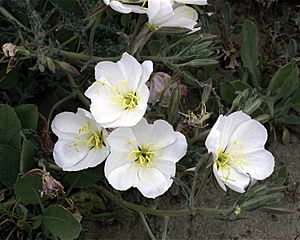Oenothera deltoides subsp. howellii facts for kids
Quick facts for kids Oenothera deltoides subsp. howellii |
|
|---|---|
 |
|
| Conservation status | |
| Scientific classification |
|
| Kingdom: | Plantae |
| Clade: | Tracheophytes |
| Clade: | Angiosperms |
| Clade: | Eudicots |
| Clade: | Rosids |
| Order: | Myrtales |
| Family: | Onagraceae |
| Genus: | Oenothera |
| Species: | |
| Subspecies: |
O. d. subsp. howellii
|
| Trinomial name | |
| Oenothera deltoides subsp. howellii (Munz) Klein
|
|
The Antioch Dunes evening primrose (scientific name: Oenothera deltoides subsp. howellii) is a very special and rare plant. It is an endangered species, which means it is in danger of disappearing forever. This unique flower belongs to the evening primrose family.
What Does the Antioch Dunes Evening Primrose Look Like?
This primrose is a short plant that lives for a few years. It has thick stems that can be anywhere from 4 to 40 inches long. The plant often grows in big, bushy clumps. Its leaves are grayish and shaped like a spear, about 1 to 5 inches long. They are covered with many small hairs.
The flowers of this primrose are white. Each petal is about an inch long. They have bright yellow stamens, which are the parts that hold pollen. This plant blooms from March all the way to September.
One amazing thing about the Antioch Dunes evening primrose is that its flowers open for only one night! These special flowers are also a main food source for a rare type of bee. This bee is called the Sphecodogastra antiochensis, also known as the Antioch Dunes sweat bee.
Where Does This Special Plant Live?
The Antioch Dunes evening primrose grows only in one very specific place. It lives in a sensitive sand dune habitat in California. This area is near where the Sacramento River and the San Joaquin River meet.
In 1979, the Antioch Dunes evening primrose was officially declared an endangered species. Today, it only lives in the Antioch Dunes National Wildlife Refuge. This refuge is the last small piece of a nine-kilometer stretch of sand dunes.
The refuge was created in 1980 to help save this plant from extinction. It also protects other endangered species. These include the Lange's metalmark butterfly (Apodemia mormo langei) and the Contra Costa wallflower (Erysimum capitatum var. angustatum).
The Antioch Dunes National Wildlife Refuge was the first national wildlife refuge in the United States. It was made specifically to protect endangered plants and insects. Because these species are so sensitive, you can only visit the refuge with supervision.
Why Is It Endangered?
Being an endangered species means a plant or animal is at high risk of dying out. In 2007, experts reviewed the status of the Antioch Dunes evening primrose. They decided that it still needed to be protected. Its endangered status remains unchanged. This means it is still very important to protect its habitat and help it survive.


